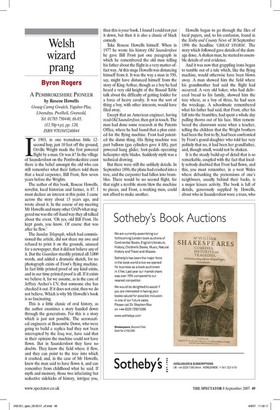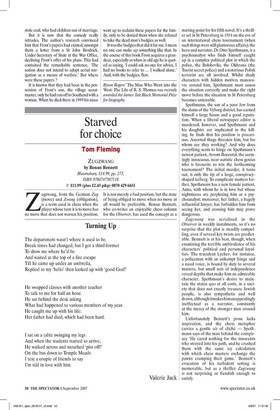Welsh wizard prang
Byron Rogers A PEMBROKESHIRE PIONEER by Roscoe Howells Gwasg Can-eg Gwalch, Ysgubor Plas, Llwynthys, Pwelheli, Gwynedd, Tel: 01785 750440, £6.85, (f1.50p -Fp), pp. 120, ISBN 9781845240844 1 n 1903, in one tremulous little 12second hop, just 10 feet off the ground, Orville Wright made the first powered flight by a man. Or was it? In the village of Saundersfoot on the Pembrokeshire coast there is the belief amongst the old who can still remember what their fathers told them that a local carpenter, Bill Frost, flew seven years before the Wrights.
The author of this book, Roscoe Howells, novelist, local historian and farmer, is 87. I must declare an interest at this point. I came across the story about 15 years ago, and wrote about it. In the course of my meeting Mr Howells and many other OAPs what staggered me was the off-hand way they all talked about the event. 'Oh yes, old Bill Frost. He kept goats, you know. Of course that was after he flew.'
The Sunday Telegraph, which had commissioned the article, did not share my awe and refused to print it on the grounds, unusual for a newspaper, that it did not believe any of it. But the Guardian sturdily printed all 3,000 words, and added a dramatic sketch, for no photograph exists of Frost's flying machine. In fact little printed proof of any kind exists, and in our time printed proof is all. If it exists we believe it, for we assume, as in the case of Jeffrey Archer's CV, that someone else has checked it out. If it does not exist, then we do not believe. Which is why Mr Howells's book is so fascinating.
This is a little classic of oral history, as the author examines a story handed down through the generations. For this is a story which is just not possible. The aeronautical engineers at Boscombe Down, who were going to build a replica had they not been interrupted by the Iraq war, have said that in their opinion the machine could not have flown. But in Saundersfoot they have no doubts. They know the field where it flew, and they can point to the tree into which it crashed, and, in the case of Mr Howells, knew the man said to have flown it, and can remember from childhood what he said. If myth and memory, those two infuriating but seductive sidekicks of history, intrigue you, then this is your book. I found I could not put it down, but then it is also a classic of black comedy.
Take Roscoe Howells himself. When in 1977 he wrote his history Old Saundersfoot he gave Bill Frost just one paragraph in which he remembered the old man telling his father about the flight in a very matter-offact way. At this stage Howells was distancing himself from it. It was the way a man in 550, say, might have distanced himself from the story of King Arthur, though as a boy he had heard a very old knight of the Round Table talk about the difficulty of getting fodder for a force of heavy cavalry. It was the sort of thing a boy, with other interests, would have filed away.
Except that an American engineer, having read Old Saundersfoot, then got in touch. The man had done some research at the Patents Office, where he had found that a plan existed for the flying machine. Frost had patented the damn thing. His flying machine was part balloon (gas cylinders gave it lift), part powered hang glider, foot-pedals operating helicopter-style blades. Suddenly myth was a technical drawing.
But there were still the unlikely details. In September 1896, the plane had crashed into a tree, and the carpenter had fallen into brambles. There would be no second flight, for that night a terrible storm blew the machine to pieces, and Frost, a working man, could not afford to make another.
Howells began to go through the files of local papers, and, to his confusion, found in the Tenby and County News of 30 September 1896 the headline 'GREAT STORM'. The story which followed gave details of the damage done. A shaken man, he started to assemble details of oral evidence.
And it was now that grappling irons began to tumble out of a tale which, like the flying machine, would otherwise have been blown away. A man showed him the field where his grandmother had said the flight had occurred. A very old baker, who had delivered bread to his family, showed him the tree where, as a boy of three, he had seen the wreckage. A schoolmate remembered what his father had said, that Frost, after his fall into the brambles, had spent a whole day pulling thorns out of his face. Men remembered the classroom scene when a teacher, telling the children that the Wright brothers had been the first to fly, had been confronted by Frost's grand-daughter who told her very politely that no, it had been her grandfather, and, though small, would not be shaken.
It is the steady build-up of detail that is so remarkable, coupled with the fact that locally nobody doubted that Frost had flown, and this, you must remember, in a west Wales where debunking the pretensions of one's neighbours, usually behind their backs, is a major leisure activity. The book is full of details, generously supplied by Howells, about who in Saundersfoot wore a truss, who stole coal, who had children out of marriage.
But it is now that the comedy really intrudes. The author's research convinced him that Frost's papers had existed, amongst them a letter from a St John Brodrick, Under-Secretary of State at the War Office, declining Frost's offer of his plans. This had contained the remarkable sentence, 'The nation does not intend to adopt aerial navigation as a means of warfare.' But where were these papers ?
It is known that they had been in the possession of Frost's son, the village scoutmaster, only he had run off to Southend with a woman. When he died there in 1949 his niece went up to reclaim these papers for the family, only to be denied them when she refused to take the dead man's budgies as well.
It was the budgies that did it for me. I mean no one can make up something like that. In the course of this book Frost acquires a grandeur, especially as when in old age he is quoted as saying, 'I could ask no one for advice, I had no books to refer to ... I walked alone.' And, with the budgies, flew.
Byron Rogers' The Man Who Went into the West: The Life of R. S. Thomas was recently awarded the James Tait Black Memorial Prize for biography.




































































 Previous page
Previous page